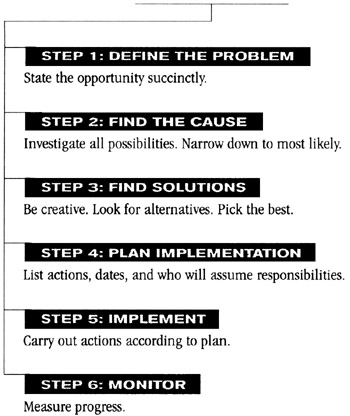Problem-Solving - The Top Ten Principles
Most people would rather die than think; in fact, they do so.
BERTRAND RUSSELL
Organizations grapple with the same problems year after year, wasting incredible amounts of time and money. The reason for their failure to resolve problems is the lack of a process. Using simple principles, you can resolve problems quickly and effectively. Here's how:
-
Prioritize problems. Deal with key issues first. The 19th century Italian economist Alfredo Pareto taught us to differentiate between the critical few and the trivial many (later known as the 80/20 rule).
-
Focus on problems over which you have control. Problems can be classified into those over which you have
-
full control;
-
some control;
-
no control.
-
-
Clean up your own backyard first. Don't look for problems in other areas until you are perfect! Your own problems usually can be fixed the quickest. Then go on to problems that require the co-operation of your boss or the people in the next department. Do not get frustrated about problems over which you have no control. Leave them. If they really bother you, bring them to the attention of senior management and then get back to solving your own issues.
-
Follow a step-by-step approach. Problem-solving is most effective when it follows a sequence of steps (see the Problem-Solving Road Map on page 249). Without such an approach, people often start with solutions. Don't jump to conclusions or try to solve problems before defining them or finding their real causes. This wastes time and money, since the solution might not remove the root cause.
-
Rely on data whenever possible. Facts are always more compelling than opinions. Unless the problem is small or insignificant, collect statistics to provide answers to the five Ws and an H:
-
Who is causing the problem?
-
What is causing the problem?
-
When does it happen?
-
Where does it occur?
-
Why does it happen?
-
How does it happen?
-
-
Break the problem down so you can deal with one aspect at a time. Problems having to do with quality, communications, and productivity can be enormous and may defy solution. To reduce their impact, deal with these problems in the same way that you would eat an elephant: take one bite at a time!
-
Use a team approach where necessary. Remember, many hands make light work. The greater the involvement and contribution of others, the more the commitment to implementing the solution.
-
Involve people who are part of the process. Every organization is staffed with people anxious and willing to solve problems, and they bring a variety of talents to team problem-solving. Use them. Don't try to do everything yourself; you'll become a dumping ground for problems. Some people are
-
good at detail work and can collect data accurately;
-
creative and can find ingenious new ways of doing things;
-
good at group process and able to develop team spirit and resolve conflict.
-
-
Don't be bound by an old paradigm. There is a lot of conventional wisdom about how things should be done. Sweep it away! Look for new and innovative solutions. Brainstorm (See Problem-Solving: Creativity). Get lots of ideas, even wacky ones. Build on some, combine others. Then decide on the best. The more unconventional the idea, the more you might be inclined to pilot it. After a successful test, implement it across the board.
-
Get a fresh perspective on old problems. Get the opinion of new employees. Since these associates are not stuck in existing paradigms, they probably have new ideas for solving old problems.
PROBLEM-SOLVING ROAD MAP

EAN: N/A
Pages: 109